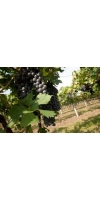Corvinoni

Corvinoni, or Corvinone, is relatively new to wine lovers as it was formally added in 1993 by the National Catalogue of Varieties of Vine Wine. Corvinoni gives a nose of perfume and is fruity or spicy on the pallet. Corvinoni is full-bodied with a good amount of tannins. Corvinoni is often used to produce Amarone and Recioto Valpolicella wines. Corvinoni is known for the large leaves and grape clusters with compact generous berries. There are two biotypes of this grape, Corbinon and Cruinon. The size of the grape, in addition to the leaves, are different as well as the different aging times. The name Corvinoni is derived from the rich black color that is reminiscent of the inky dark color of a raven’s feathers. It could also be derived from the corba that was transferred to the grape baskets during heavy harvesting. The Corvinoni grape does exceptionally well in stony soils, hilly regions with considerable exposure. Corvinoni is sensitive to botrytis and other diseases like sour rot. It can also be susceptible to mildew and spine desiccation.
No products found
- back
Selected Options
Grape Types
Categories
Pricing
Countries
Regions
Grape Types
Wineries
Organic/Free Shipping
Paul Hobbs George Menini Estate Chardonnay is made from 100 percent Chardonnay.
Located on the southwestern edge of the Russian River Valley appellation in an area known as the Sebastopol Hills, this Chardonnay from George Menini Estate displays pale straw in color and boasts an elixir of white and yellow florals, tart yellow apple, bartlett pear, and baking spice. A precise yet supple wine with notes of juicy Gravenstein apple, vibrant sea salt, and crushed rock, complemented by a cool-climate zing of acidity. An impressive level of complexity for a young vineyard.
Review:
Lots of pears and pear blossom with lemon rind undertones. Medium body with plenty of fruit and energetic acidity with a pumice undertone. Some terra-cotta, too. Flavorful finish. Salty, too. Complex. Lots going on here. Drink or hold.
-James Suckling 97 Points
Paul Hobbs George Menini Estate Pinot Noir is made from 100 percent Pinot Noir.
Brilliant ruby red in the glass, the 2022 vintage follows the color with matching aromas of wild mountain strawberry, raspberry, and cherry infused with hints of black tea. On the palate, this wine has the texture of thick satin, evolving seamlessly with subtle energy and pleasant tension. Elegant, fine-grained tannins run through a lingering, juicy finish.
Review:
Wow, a super well-structured, vital wine with oodles of generous black fruit flavors on a firm frame that will help it age well and improve with time. Black cherries, blackberries, blueberries, forest floor nuances and a slight smoky, stemmy character from using mostly Calera-clone grapes, with 15% whole clusters and 30% new French oak. Great interplay between layered fruit and a fresh, crunchy texture. Drinkable now, but best from 2030.
-James Suckling 98 Points & #54 in Top 100




